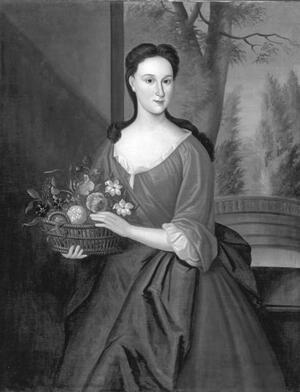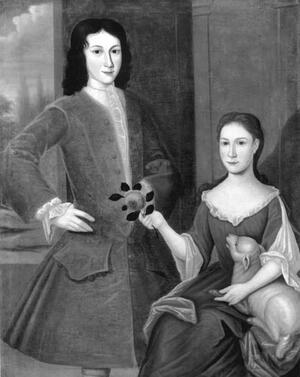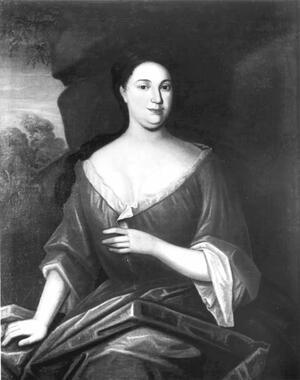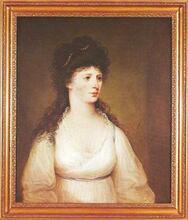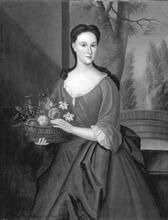Bilhah Abigail Levy Franks
Born in England, Bilhah Franks spent most of her life in New York City, where she was active in Shearith Israel synagogue as well as in the secular society of her well-to-do Christian neighbors. But she had to send her children back to England, and though Franks wrote to them often, she never saw them again. Her letters to her son relate her experiences of New York society and her combination of devotion to Judaism and anger at its superstitions. Through her writing, Franks offers a window into the attempts of colonial American Jews to retain their religious identity while still participating fully in the larger society.
No colonial American woman left a more engaging portrait of contemporary family, political, and social life than Bilhah “Abigail” Franks. Her letters to her son Naphtali in England, covering the years 1733–1748, discuss the lives of his growing siblings, political and social life in early eighteenth-century New York City, her extensive reading, and her love of good Scottish snuff. The letters also shed extraordinary insight into the efforts of colonial American Jews to establish a functional equilibrium between being Jewish and being part of the larger colonial Christian society.
Early Life
Abigail Levy was born in London, the eldest of five children of German-Jewish immigrant Moses Raphael Levy and his first wife, Richea Asher. The family moved to New York City by 1695, and in 1712, Abigail Levy married London-born Jacob Franks, son of a German-Jewish merchant and broker in England. The Frankses had nine children, born between 1715 and 1742. The family was active in New York’s Jewish life—they belonged to congregation Shearith Israel, where Jacob Franks was one of four men to lay the cornerstone of the new Mill Street synagogue in 1729 and where he served as president in 1730. They were also active in broader Christian society, among whose women Franks counted her best friends.
Franks reveled in the openness of New York society, rejoicing in the “Faire Charecter” the family enjoyed among both Christians and Jews. But the family never achieved the financial stability the Franks and Levy families had in England, and one by one, beginning around 1732, Jacob and Abigail sent their children to England in order to prosper. Abigail Franks probably never saw her adult children again after their departure, or any of her English grandchildren. For the remainder of her life, the exchange of letters, painted portraits, and small gifts were the only contacts she had with them.
Thirty-seven letters of the Franks family are known to survive, dating from May 7, 1733, to October 30, 1748. All are addressed to Naphtali Franks in England. Thirty-four are from Abigail, one is from Jacob, and two are written by his brother David. They discuss local politics, family and community activities, and aspects of the Franks family’s trans-Atlantic business. Abigail Franks’ letters offer a critical perspective of an early American Jewish woman’s extended thoughts on the fit and fate of Judaism in colonial New York.
Life as a Mother
Franks worked diligently to raise her children as practicing Jews. Daughters and sons received instruction in Hebrew, and the family practiced traditional Judaism, honoring the Sabbath, keeping Term used for ritually untainted food according to the laws of Kashrut (Jewish dietary laws).kosher, and keeping the Jewish holidays. Franks urged Naphtali in England to keep up with his morning devotions and cautioned him to avoid nonkosher food, warning him off even his uncle’s table. But Franks was also critical of much in Judaism. In the open air of colonial America, and likely under the influence of the broad range of philosophers and novelists she read—among her favorite authors were Pope, Fielding, Smollett, Dryden, Montesquieu, Addison, and Gentleman’s Magazine, all supplied to her by Naphtali—she yearned for a Calvin or a Luther to reform what she deemed Judaism’s worst superstitions. She was scathing in her critique of the New York Jewish community, calling its ladies a “Stupid Set of people” and despairing about the pool of Jewish suitors available for her daughters.
But the costs of such ambiguities were high. With a limited pool of Jewish marriage prospects, Franks’ disdain for most of them, and the entire Franks family’s desire to be part of the larger New York community, it was perhaps inevitable that two of her children would take non-Jewish spouses. Oldest daughter Phila was the first. In the fall of 1742, Phila secretly married Oliver de Lancey, son of a prominent and successful Huguenot New York merchant family.
For six months they kept the match secret, but in the spring of 1743, Phila announced the deed and went to live with her husband. Abigail’s letters to Naphtali spoke of her sense of betrayal and her pain, and she never spoke to Phila again. This was not the last hurt she would feel. Son David married Margaret Evans, a Christian daughter of one of Abigail’s close friends. Her younger children seem never to have married at all. Even sons Naphtali and Moses, who married their English first cousins, watched as all of their own grandchildren left the Jewish faith. Of Jacob and Abigail Franks’ more than two dozen grandchildren, not one of them appears to have passed on Judaism to his or her descendants.
Other family connections were complex as well. In 1718, Franks’ father, widowed in 1716, married Grace Mears, with whom he had seven children. Franks despised her stepmother and spared no insult in her prose. But when Grace Levy, left a widow with many young children in 1728, made a bad remarriage in 1735, Franks’ assessments of her shifted. Through Franks’ letters a rare portrait of a widowed colonial Jewish woman emerges—of Grace Mears Levy Hays as female shopkeeper who single-handedly supported and raised her young family, survived a deeply unhappy second marriage, and died brokenhearted, too young, and finally admired by her oldest stepdaughter.
Franks Family. Papers. American Jewish Historical Society, Waltham, Mass.
Hershkowitz, Leo, and Isidore S. Meyer, eds. Letters of the Franks Family (1733–1748) (1968).
Smith, Ellen. “Portraits of a Community: The Image and Experience of Early American Jews.” In Facing the New World: Portraits of Jews in Colonial and Federal America (1997).

